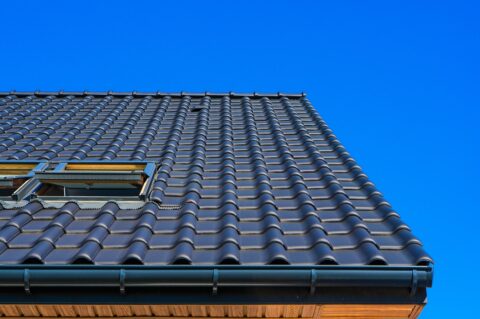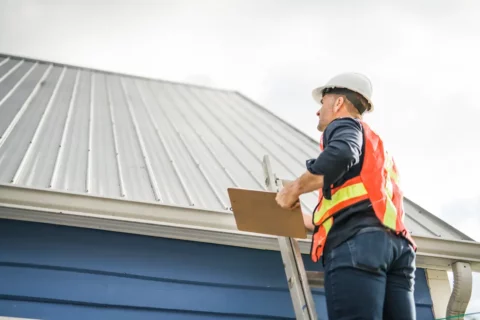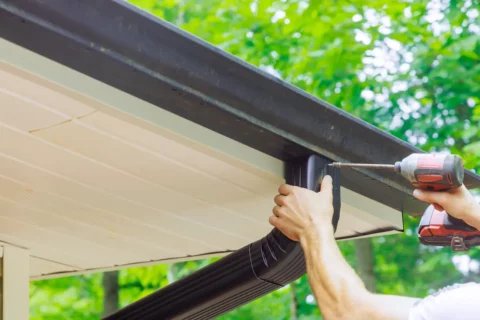As a homeowner, you always have to consider any kind of weather condition as a threat to the condition of your home. On the surface, snow would seem like the least of your problem since it’s so light and fluffy when falling. However, unlike water that rolls off a roof, snow accumulates.
You would be amazed at how much a good snowfall could weigh. According to some experts, ordinary new snow weighs about 3.59 pounds per cubic foot. If the snow is mixed with ice, it can weigh significantly more. A half an inch of snow on your roof probably isn’t a big deal. Two feet of snow and ice sitting on your roof for a long period is a significantly bigger issue.
As a prudent homeowner, you need to be wary of things that can damage your home’s structure, especially your roof. Like it or not, you don’t want to leave accumulated snow on your roof any longer than necessary. With that said, it would be a good idea to learn how to safely remove snow from your roof. The last thing you want is to see someone like yourself get injured trying to clear snow away.
If you live in an area that gets a lot of snowfall, you should appreciate reading the following information.
How to Safely Remove Snow From Your Roof
Before you grab a broom and shovel and start climbing on the roof to remove snow, you should take a minute to strategize. It’s very important that you take any and all of the necessary precautions to ensure your safety.
No one is suggesting that you climb on the roof to remove snow every time it snows. What we are suggesting is you keep an eye out for signs that snow/ice could be compromising the structure of your roof. Doing this is particularly important if you live in an area that gets a lot of frequent snowfall.
To help you gain a better understanding of when your roof might be at risk from snow, here are some of the factors that warrant consideration:
- The slope of the roof
- The shape of the roof
- The age of the home and the roof
- The history of roof maintenance
- The frequency of exposure to harsh weather conditions like wind, hail, and snow
- The type of snowfall that is common in your area (snow or icy snow)
If we were to choose just one of these factors that we believe would be the most important factor, we would go with the slope of the roof. Let’s look at the effects of snowfall on two primary types of roofs: sloped roofs and flat roofs.
Sloped Roofs
If a home with a sloped roof was built completely to code, it was built to withstand pressure of 20 to 35 pounds per square foot. Even the heaviest snow/ice combination would probably top out at 20 pounds per square foot. Therefore, a sloped roof built to code probably doesn’t warrant snow removal.
Keeping in mind the term “to code” refers to more recent codes, an older home with an
older roof might not be up to code by recent standards. It could well be that the roof you have was only built to hold up to say 20 pounds per square foot of pressure.
If your home and roof fall into this category, we would suggest you get in the habit of clearing snow off the slopes if the accumulation exceeds 12 inches.
Flat Roofs
If you have a flat roof over any portion of your house, you are at greater risk of roof damage from snowfall. At issue is the fact flat roofs don’t allow for snow to fall off the roof. It simply accumulates until the snowfall stops and melting begins. Another issue is the fact sloped roofs have a built-in low pitch, which allows more snow to accumulate.
Given the higher degree of risk with a flat roof, we would suggest you get in the habit Of clearing snow every time before it accumulates above 10 inches.
Risks associated with removing snow from the roof
Before you head up the ladder, you need to consider all the possible dangers you could encounter while trying to remove snow from the roof. Here are a few notable dangers of roof snow removal:
- The footing will be slippery and treacherous
- You will be exposed to cold air (dress warmly to avoid hypothermia and frostbite)
- Power lines and metal ladders and tools don’t mix well
- It’s hard work so avoid over-exertion
The snow removal process
Before you head up the ladder, you’ll want to make sure you have all the materials and tools you’ll need. This will cut down on ladder traffic, avoiding unnecessary risk in the process. We would suggest these tools:
- Shovel
- Rake
- Extension poles to remove obstacles like power lines
- Roofmelt pellets (optional)
- Snow blower (optional)
In addition to these tools, you should take the following precautionary steps:
- Do not attempt to remove snow in bad weather conditions
- Do not work alone
- If possible, secure yourself to a sturdy object when on the roof
- Be careful to not cause collateral damage to shingles, flashing, or gutters
- Clear an area to secure the ladder
Based on this information, you might find that the process of removing snow from your roof is more dangerous and complicated than you might have originally thought. No matter what, your safety and the safety of others should be the number one concern. Roofs can be replaced, but health and life cannot.
If you want to avoid the work and risk, we can offer you our professional snow-clearing services if you want to reach out for help through our website.




